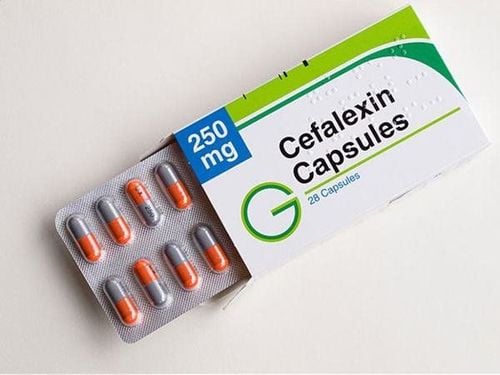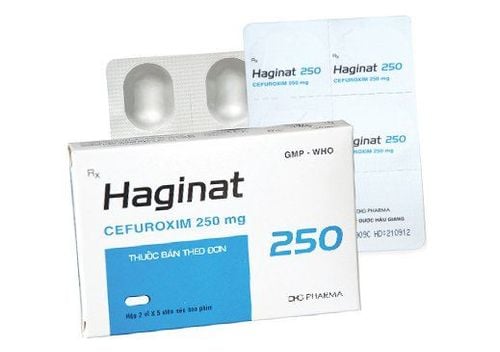This is an automatically translated article.
Sagadinir has the active ingredient Cefdinir, a Cephalosporin antibiotic. The mechanism of action of the drug is to inhibit the synthesis of the bacterial cell wall. The drug is often indicated in the treatment of respiratory and urinary tract infections.1. What is Sagadinir?
Drug Sagadinir is a Cephalosporin antibiotic. The drug's mechanism of action is to inhibit bacterial cell wall synthesis by binding to one or more Penicillin-binding proteins (PBPs), thereby inhibiting the final transpeptidation step of Peptidoglycan synthesis in bacterial cell wall, thereby inhibiting cell wall biosynthesis. Bacteria are eventually lysed by the continued action of autolytic enzymes (autolysin and murein hydrolase).
The maximum concentration of Cefdinir in the blood plasma after 2 - 4 hours of dosing. The predicted bioavailability of the drug is approximately 21% after a dose of 300 mg. Approximately 60% - 70% of the drug Cefdinir is bound to plasma proteins and this binding is independent of drug concentration. Cefdinir is not significantly metabolized and is eliminated primarily by the kidneys. The mean half-life of the drug is about 1.7 hours.
2. What is the use and dosage of Sagadinir? Treatment of acute otitis media:
Oral: 300 mg x 2 times/day or 600 mg x 1 time a day; treatment duration from 5 to 7 days (mild to moderate infections) or 10 days (severe infections) Urinary tract infections (indicated when first-line drugs cannot be used):
Cystitis, cystitis uncomplicated acute simple bladder (infection limited to the bladder without signs of upper urinary tract, prostate, or systemic infection): 300mg twice daily for 5 to 7 days; Urinary tract infections, complicated (including pyelonephritis): Take 300mg x 2 times/day for 10 to 14 days. Note: Oral beta-lactam therapy should generally be followed after appropriate parenteral therapy. Streptococcal pharyngitis, group A:
Note: To avoid the development of drug resistance, narrower-spectrum Cephalosporins (eg, Cephalexin or Cefadroxil) are preferred when possible. The recommended dose is 300mg twice daily for 5 to 10 days or 600mg once daily for 10 days.
3. Side effects of the drug Sagadinir
Frequency > 10%:
Gastrointestinal: Diarrhea. Frequency 1 to 10%:
Dermatology: Skin rash; Endocrine and metabolic: Decreased serum bicarbonate, increased gamma-glutamyl transferase, increased lactate dehydrogenase; Gastrointestinal: Abdominal pain, nausea, vomiting; Urinary: Increased proteinuria, microscopic hematuria, vaginitis, vulvovaginal candidiasis; Hematology: Eosinophilia, leukocytosis (increased or decreased neutrophils), leukocytosis, lymphocytosis, thrombocytosis; Liver: Increased serum alkaline phosphatase; Nervous system: Headache. Frequency <1%:
Dermatology: Skin candidiasis, maculopapular rash, pruritus; Endocrine and metabolic: Decrease in serum calcium, decrease in serum phosphate, urinary glucose, increase in serum glucose, increase in serum phosphate, increase in serum potassium; Digestive: Anorexia, nausea, constipation, indigestion, flatulence; Hematology: Decrease in hematocrit, decrease in hemoglobin, decrease in white blood cell count, increase in monocytes; Liver: Increased serum alanine aminotransferase, increased serum aspartate aminotransferase, increased serum bilirubin; Central nervous system: Dizziness, drowsiness or insomnia; Musculoskeletal: Weakness; Kidney: Change in specific gravity of urine, increase blood urea nitrogen, increase urine pH.
4. Note when using Sagadinir
Fungal and bacterial superinfection with prolonged use of Cefdinir; Colitis: Use with caution in patients with a history of colitis; Renal impairment: Use with caution in patients with renal impairment (CrCl <30 mL/min); dose adjustment according to renal function; Iron-containing products: Cases of slightly red stools have been reported with the concomitant use of Cefdinir and iron-containing products due to the formation of an unabsorbable complex in the gastrointestinal tract; Side effects of note are gastrointestinal disturbances including antibiotic-associated diarrhea (with or without Clostridioides difficile infection), nausea, and vomiting. Most of these cases are mild and self-limiting. However, Clostridioides difficile infection may account for >20% of cases in children, adolescents, and adults. The mechanism is that antibiotics disrupt the balance of the gut microbiota. The median duration of this adverse event was 3 to 18 days for adult patients and 2 to 6 days for pediatric patients; Hypersensitivity reactions (immediate and delayed) range from skin rash to rare cases of anaphylaxis. Serious skin adverse reactions including Stevens-Johnson syndrome and toxic epidermal necrolysis have been reported; Pregnancy: No increased risk of birth defects was found after first-trimester exposure to cephalosporins; Lactation: Cefdinir was not detectable in breast milk following a single dose of cefdinir 600 mg. In general, if antibiotics are present in breast milk, associated changes in the gut microbiota may occur, so the neonate should be monitored for gastrointestinal disturbances, such as thrush and diarrhea. . In general, Sagadinir 300mg is an antibiotic commonly indicated in urinary tract infections, otitis media, pharyngitis. Important side effects to watch out for when using the drug are gastrointestinal disturbances due to imbalance of intestinal flora and hypersensitivity reactions. When experiencing unusual effects while taking the drug, patients should contact their doctor or pharmacist for advice.
Please dial HOTLINE for more information or register for an appointment HERE. Download MyVinmec app to make appointments faster and to manage your bookings easily.













